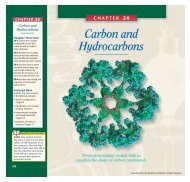You also want an ePaper? Increase the reach of your titles
YUMPU automatically turns print PDFs into web optimized ePapers that Google loves.
SECTION 9-2<br />
Classroom Practice<br />
The following may be used<br />
as a teamwork exercise or for<br />
demonstration at the chalkboard<br />
or on an overhead projector.<br />
PROBLEM<br />
Pressure as a function of<br />
depth<br />
Find the atmospheric pressure<br />
at an altitude of 1.0 × 10 3 m if the<br />
air density is constant. Assume<br />
that the air density is uniformly<br />
1.29 kg/m 3 and P 0 = 1.01 × 10 5 Pa.<br />
Answer<br />
8.8 × 10 4 Pa<br />
PRACTICE GUIDE 9C<br />
Solving for:<br />
P PE Sample, 1, 2;<br />
Ch. Rvw. 19a,<br />
34*, 35*, 46*,<br />
57b*<br />
PW 5–6<br />
PB 5–7<br />
h PE 3, 4; Ch. Rvw.<br />
57a*<br />
PW 3–4<br />
PB Sample, 1–4<br />
r PW Sample, 1–2<br />
PB 8–10<br />
ANSWERS TO<br />
Practice 9C<br />
Pressure as a function of<br />
depth<br />
1. 1.11 × 10 8 Pa<br />
2. a. 1.03 × 10 5 Pa<br />
b. 1.05 × 10 5 Pa<br />
3. 0.20 m<br />
4. 20.1 m<br />
330<br />
330<br />
SAMPLE PROBLEM 9C<br />
PROBLEM<br />
SOLUTION<br />
PRACTICE 9C<br />
Chapter 9<br />
Pressure as a function of depth<br />
Calculate the absolute pressure at an ocean depth of 1.00 × 10 3 m. Assume<br />
that the density of the water is 1.025 × 10 3 kg/m 3 and that P 0 = 1.01 × 10 5 Pa.<br />
Given: h = 1.00 × 10 3 m P 0 = 1.01 × 10 5 Pa r = 1.025 × 10 3 kg/m 3<br />
g = 9.81 m/s 2<br />
Unknown: P = ?<br />
Use the equation for fluid pressure as a function of depth from page 328.<br />
P = P 0 + rgh<br />
P = P 0 + (1.025 × 10 3 kg/m 3 )( 9.81 m/s 2 )(1.00 × 10 3 m)<br />
P = 1.01 × 10 5 Pa + 1.01 × 10 7 Pa<br />
P = 1.02 × 10 7 Pa<br />
Pressure as a function of depth<br />
1. The Mariana Trench, in the Pacific Ocean, is about 11.0 km deep. If<br />
atmospheric pressure at sea level is 1.01 × 10 5 Pa, how much pressure<br />
would a submarine need to be able to <strong>with</strong>stand to reach this depth?<br />
(Use the value for the density of sea water given in Table 9-1.)<br />
2. A container is filled <strong>with</strong> water to a depth of 20.0 cm. On top of the water<br />
floats a 30.0 cm thick layer of oil <strong>with</strong> a density of 0.70 × 10 3 kg/m 3 .<br />
a. What is the pressure at the surface of the water?<br />
b. What is the absolute pressure at the bottom of the container?<br />
3. A beaker containing mercury is placed inside a vacuum chamber in a<br />
laboratory. The pressure at the bottom of the beaker is 2.7 × 10 4 Pa. What<br />
is the height of the mercury in the beaker? (See Table 9-1 for the density<br />
of mercury. Hint: Think carefully about what value to use for atmospheric<br />
pressure.)<br />
4. Calculate the depth in the ocean at which the pressure is three times<br />
atmospheric pressure. (Use the value for the density of sea water given in<br />
Table 9-1.)<br />
Copyright © by Holt, Rinehart and Winston. All rights reserved.
















